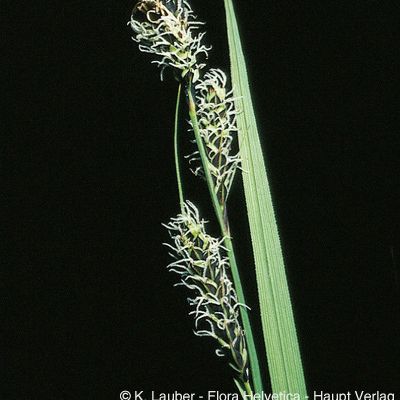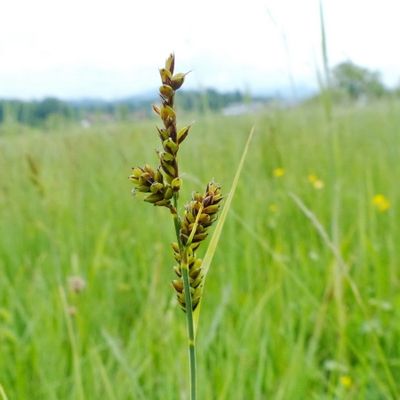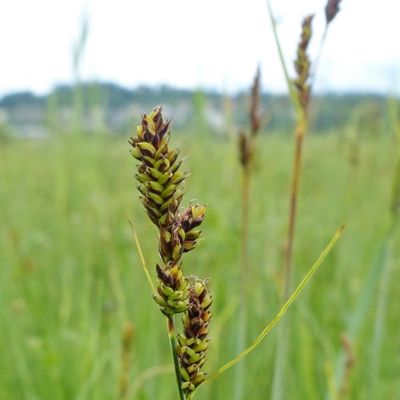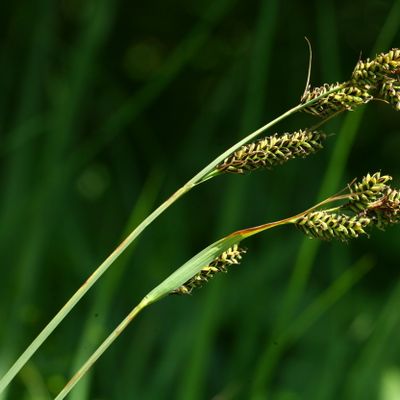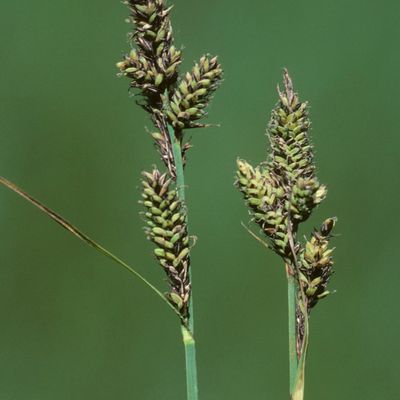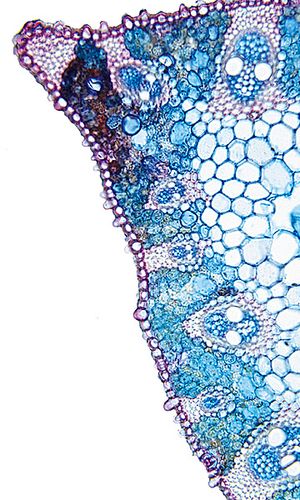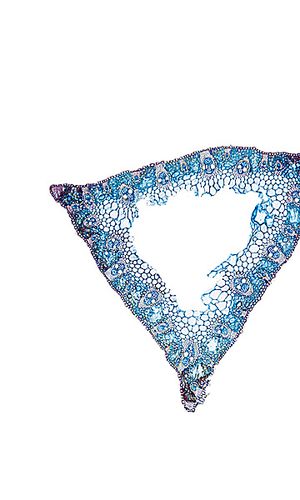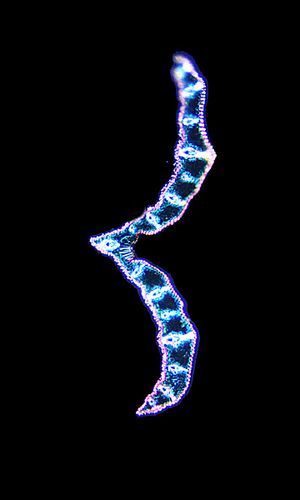Carex hartmanii Cajander
1009860
Species
ISFS : 88400
Checklist : 1009860
ISFS : 88400
Checklist : 1009860
Contains :
Synthesis
Species description (© Flora Helvetica 2018)
Ähnlich wie C. buxbaumii, aber Blätter grün, Ähren zylindrisch, bis 3,5 cm lang, die beiden untersten deutlich abgerückt, das unterste Hochblatt den Blütenstand kaum überragend, Fruchtschläuche nur 2-3 mm lang, mit 2 geraden Zähnen.Flowering period (© Flora Helvetica 2018)
5-6Habitat and distribution inside Switzerland (© Flora Helvetica 2018)
Kalkhaltige Flachmoore / kollin(-montan) / ZH, SG, VD (Les Grangettes), VSWorld distribution (© Flora Helvetica 2018)
EurosibirischEcological indicator (© Landolt & al. 2010)
4w+22-43+3.h.2n=?Status
IUCN status
EndangeredNational Priority
3 - medium national priorityInternational responsibility
1 - weakConservation
Threats
Drainage, Austrocknung
Aufgabe der traditionellen Streunutzung
Verbuschung
Beweidung, Eutrophierung
Überbauung, Aufschüttung, Umwandlung in Landwirtschaftsland
Wenige, isolierte Populationen, in der Schweiz sehr kleines Verbreitungsgebiet.
Anatomy
Summary of leaf anatomy (German)
Obere Epidermiszellen grösser als untere. Epidermis mit Papillen. Verbindungs-Steg zwischen oberer und unterer Epidermis aus verholzten und nicht verholzten Zellen. Leitbündel im Verbindungs-Steg unten eingebettet. Leitbündelhülle verholzt.Summary of stem anatomy (German)
Umriss exakt dreieckig. Leitbündel in mehreren Reihen. Rechteckige Stützen. Epidermiszellen verholzt. Epidermiszellen mit Papillen.Description
Culm-diameter 1-2 mm, wall large, radius of culm in relation to wall thickness approximately 1: 0.5. Outline triangular, acutely. Culm-center hollow and surrounded by many large thin-walled, not lignified cells. Epidermis papillous (bulliform). Large vascular bundles arranged in one peripheral row. Small or rudimentary vascular bundles within the chlorenchyma. Chlorenchyma in round, oval, square or rectangular groups. Sclerenchyma belt absent. Groups of sclerenchyma square or rectangular. Vascular bundles collateral closed. Sclerenchymatic sheath around vascular bundles circular large, 3 to x cells. Vessels arrangement in vascular bundles in lateral position. Largest vessel in the bundle 20-50 μm. Cavities (intercellulars) between parenchyma-cells small, often triangular. Cavities (intercellulars) and aerenchyma in any other form. Crystals absent.Distribution map
Habitat and distribution inside Switzerland
ZH, SG, VD (Les Grangettes), VSWorld distribution
EurosibirischEcology
Life form
Perennial hemicryptophyte
Habitats
Milieux Phytosuisse (© Prunier et al. 2017)
Habitats © Delarze & al. 2015
 | 2.3.1 - Pfeifengraswiese (Molinion) |
bold
Dominant species, influencing the appearance of the habitat
 Character species
Character species
 Less strictly linked to a specific habitat
Less strictly linked to a specific habitat
Ecological indicator values by © Landolt & al. (2010)
| Soil factors | Climatic factors | Salinity tolerance | |||
|---|---|---|---|---|---|
| Humidity Value H | 4w+ | Light Value L | 4 | Salinity Index | -- |
| Reaction Value R | 2 | Temperature factor T | 3+ | ||
| Nutriments value N | 2 | Continentality K | 3 | ||
- Ecological values legend
Humidity Value H 1 very dry 1+ dry 2 moderatly dry 2+ moist 3 medium wet 3+ wet 4 very wet 4+ soggy 5 submerged or underwater f plants living in running water u mostly submerged plants v partly submerged, partly floating plants w humidity moderately variable (± scale of 1-2) w+ highly variable humidity (scale exceeding ± 2) Reaction Value R 1 Very acid (pH 2.5-5.5) 2 acid (pH 3.5-6.5) 3 lightly acid to neutral (pH 4.5-7.5) 4 neutral to basic (pH 5.5-8.5) 5 basic (pH 6-5 -> 8.5 Nutriments value N 1 very low in nutrients 2 low in nutriments 3 medium-poor to medium-rich in nutrients 4 rich in nutriments 5 very rich in nutriments Salinity tolerance 1 halotolerant 3 halophyle Light Value L 1 very shady 2 shady 3 lighted areas 4 luminous 5 highly luminous Temperature factor T 1 alpine to nival stages (from the treeline to the snowline) 1+ suprasubalpine and upper subalpine levels (pine and larch forests) 2 subalpine level (coniferous forests without beeches up to the upper limit of spruces) 2+ lower subalpine and upper mountain stages 3 mountain level (beech and silver fir forests, in the central Alps Scots pine forests) 3+ lower mountain and upper hill levels 4 hill level (mixed deciduous oak forests) 4+ hot places, hill level 5 very hot places, hill level (only in the hottest places, typical of southern Europe) Continentality K 1 Atlantic (high air humidity, very low temperature variations, mild winters) 2 Sub-Atlantic (high air humidity, low temperature variations, relatively mild winters) 3 sub-Atlantic to subcontinental (average air humidity, moderately variable temperature, slightly low winter temperatures) 4 subcontinental (low air humidity, large temperature variations, rather cold winters) 5 continental (very low air humidity, very large temperature variations, cold winters)
Water dependency
| Rivers | 0 - No link |
| Calm water | 0 - No link |
| Ground water | 0 - No link |
Nomenclature
Accepted Name (Checklist 2017)
Carex hartmanii Cajander
Vernacular name
Deutscher Name :
Hartmans SeggeNom français :
Laîche de HartmanNome italiano :
Carice di HartmanMatch with other reference books
| Relation | Nom | Book | No |
|---|---|---|---|
| = | Carex hartmanii Cajander | Checklist 2017 | 88400 |
| = | Carex hartmanii Cajander | Flora Helvetica 2001 | 2547 |
| = | Carex hartmanii Cajander | Flora Helvetica 2012 | 2723 |
| = | Carex hartmanii Cajander | Flora Helvetica 2018 | 2723 |
| = | Carex hartmanii Cajander | Index synonymique 1996 | 88400 |
| = | Carex hartmanii Cajander | Landolt 1977 | 501 |
| = | Carex hartmanii Cajander | Landolt 1991 | 438 |
| = | Carex hartmanii Cajander | SISF/ISFS 2 | 88400 |
| = | Carex hartmanii Cajander | Welten & Sutter 1982 | 2505 |
= The taxon corresponds to the accepted taxon (Checklist 2017)
< The taxon is included in the accepted taxon (Checklist 2017)
> The taxon includes (among others) also the accepted taxon (Checklist 2017)
< The taxon is included in the accepted taxon (Checklist 2017)
> The taxon includes (among others) also the accepted taxon (Checklist 2017)
Status
Native status
-IUCN list of endangered species (© Walter & Gillett 1997) : No
Status on national Red List 2016
IUCN status:
Endangered

Additional information
IUCN criteria: C1
Status on regional Red List 2019
| Biogregraphic regions | Status | IUCN criteria |
|---|---|---|
| Jura (JU) | -- | |
| Mittelland (MP) | EN | C1 |
| Alpennordflanke (NA) | EN | C1 |
| Alpensüdflanke (SA) | -- | |
| Östliche Zentralalpen (EA) | -- | |
| Westliche Zentralalpen (WA) | CR | D |
- Legend
EX Extinct RE Regionally Extinct CR(PE) Critically Endangered, Probably Extinct CR Critically Endangered EN Endangered VU Vulnerable NT Near Threatened LC Least Concern DD Data Deficient NE Not Evaluated NA Not Applicable
National Priority Species List Status
| National Priority | 3 - medium national priority |
| Need to take action | 2 - |
| International responsibility | 1 - weak |
| Need to monitor populations | 2 - |
Protection status
| International (Bern Convention) | No | |
| VD | total protection | (02.03.2005) |
| Switzerland | -- |
- Disclaimer
InfoFlora compiles information on protected species as accurately as possible, taking it from the respective cantonal laws. In some cases, however, it was not possible to use the plant names as listed in the original text, but an interpretation of their taxonomy or nomenclature was necessary. The exact meaning of the categories „completely protected“ and „partially protected“ differs among the cantons.
InfoFlora cannot guarantee that the information on the protection status is correct and complete. In case of doubts, we recommend to look up the texts of the respective cantonal law.
Status by sector of activity
| Agriculture-related environmental objectives : | Z - | more informations |
| Forest management environmental objectives : | more informations |
Conservation
Threats and measures
Drainage, Austrocknung
Keine weitere Entwässerung
Wasserhaushalt stabilisieren und evtl. lokal leicht Vernässen
Aufgabe der traditionellen Streunutzung
Extensive Bewirtschaftung weiterführen
mehrjährige Bestände alle 2 Jahre im Herbst mähen
Schnittgut entfernen
Bewirtschaftungs- verträge
Verbuschung
Entbuschen
Beweidung, Eutrophierung
Höchstens extensiv beweiden
evtl. einzäunen
grosse Pufferzonen schaffen
Überbauung, Aufschüttung, Umwandlung in Landwirtschaftsland
Keine weiteren Flächenverluste zulassen
Wenige, isolierte Populationen, in der Schweiz sehr kleines Verbreitungsgebiet.
Schutz inkl. angemessener Pufferzonen (z. B. Ortsplanung)
regelmässige Bestandeskontrollen
Dauerflächen-Beobachtung
bestehende Schutz und Förderungsmassnahmen weiterführen, Verstärkung bestehender Populationen und Ansiedlung neuer Populationen durch Anpflanzung (nach Zwischenvermehrung)
